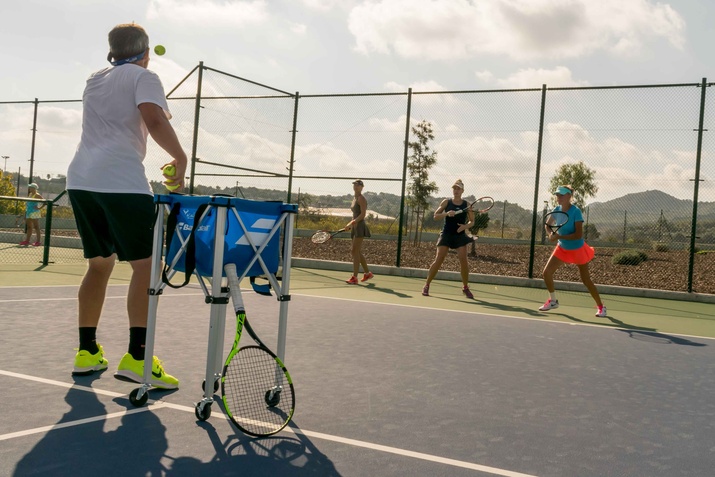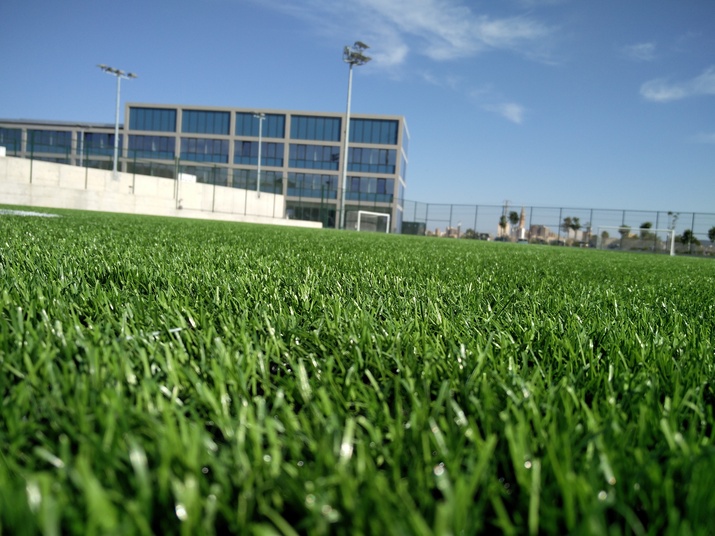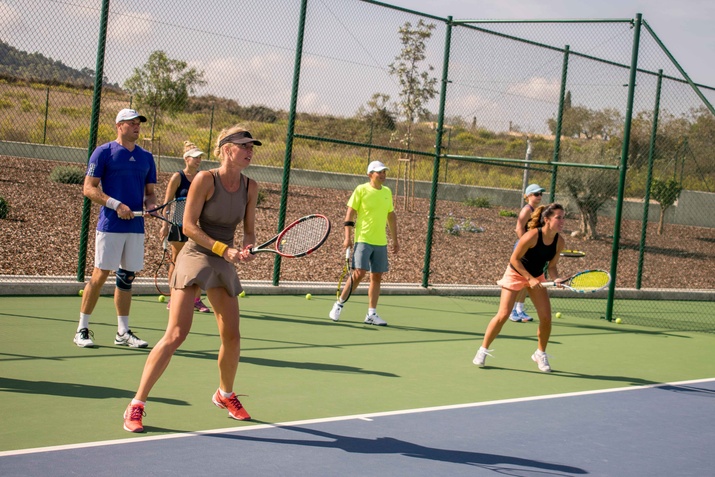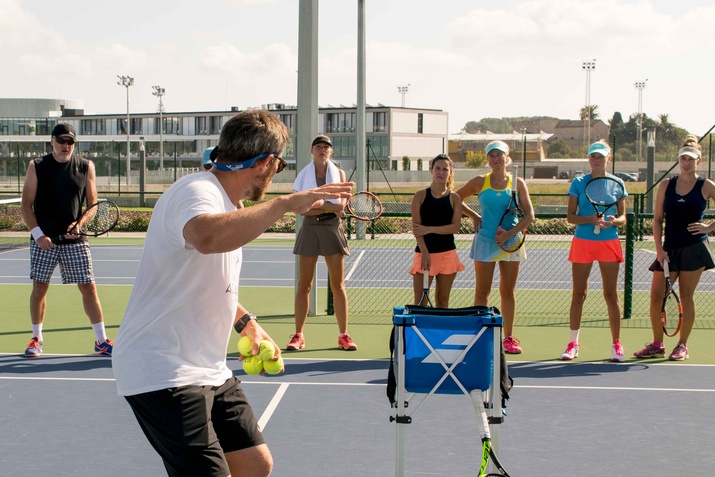Don't miss any stories → Follow Tennis View
FollowSummer Series: Rafael Nadal Academy (Part Three)
After a break during Wimbledon, Karen Helf picks up where she left off in her series on the Rafael Nadal Academy. So, what did she learn there? Karen explains in part three of the series.
Disclaimer
Before I move on I want to clarify something. It seems some my words were misinterpreted in part two of the series.
The instructor that asked me if I needed two courts did exactly the right thing. And, it was him who followed with the comment “don't worry I have insurance” releasing my pressure valve. After that, I was determined to prove him right. In a real sense, that was my first break-point. It would also be him, five days later, who told me, “you improved a lot.”
As I watched him coach a young somewhat willful boy on the next court, I was impressed by how he managed him. He would randomly call break point or match point. The response sometimes was, “come on not fair,” but if you are going to be good at tennis, you must be able to handle big moments. The more you practice those situations, the better.
The Art of Doing One Thing at a Time

This concept is probably the most valuable lesson among the many things I learned from my instructor Tomas. While these words were not explicitly spoken, they stuck in my head and still do.
Let me explain. It's not that I didn’t know focusing on one thing was important. It's just being at the Academy, I realized just how deficient I was in this skill. And while I have been working on improving since I left the RNA, it remains a huge opportunity for me.
Add on years of IT work where multitasking is hallowed as a core skill and there you have it, an adult who is constantly distracted by splitting her thoughts into multiple directions. The act of splitting your mind into two different directions means you are “absent minded” for both. I realize this may also be why I love tennis. Even when I am watching, it requires my full attention if I want to take in the complete experience. In our society, singular focus moments are unfortunately rare.
Early in my first lesson, I had the “aha” moment that just keeps going. Tomas was quick to notice that I was not stopping before hitting the ball. I would literally run through my shots. I have since recognized a parallel here with my daily life off court. His words stick in my head and whisper quite often, “in this moment are you running or hitting the ball? You cannot do both you must stop first.”
Now, as I eat in restaurants, my own mind questions me in this way, “Are you drinking wine or reading emails? Are you sightseeing or posting on Facebook?” Now, recognizing the need to focus on one thing, I have improved in many ways. The bonus, I enjoy everything more - food, music, wine, art, time with Dad, everything!
Other remarkable benefits are - I trip less, do not lose things, am breaking less stuff and experiencing a reduction in what I can only call “frustration.” I attribute this to focusing on one thing, producing better results in my life across the board. It's remarkable… and I'm not done yet.
Knowing and doing are two different things…It’s a process of constant improvement
Just when you think you’ve begun to master something, the world will give you reality checks, but only when you pay attention.
I left the academy and headed to Paris, Roland Garros bound. On the Paris metro, proud of myself for not being on my phone and taking in the moment, I looked down only to realize my shirt was on inside out. This moment reminded me of the Rio tournament when Rafa arrived back on-court after a change-over only to discover his shorts were on backward. He was forced to right the wardrobe malfunction on-court wrapped in a towel. I must admit, it’s good to know I am not alone. Lesson learned, rushing and good performance are contradictory behaviors.

Wait! It gets better!
At the French Open, I found myself in a fantastic spot following Rafa's practice. My goal, to ask Toni Nadal to sign a program for a young tennis friend of mine. While I prepared well for this moment, the execution was a bit off. Face-to-face with Toni I said in my best Spanish accent, “Por favor Toni, moment.” I told him my request was for a boy and he immediately stopped. With his hands full he asked if I could hold his bag so he could sign. Yes, of course, I said. I was excited!
I placed the bag carefully on my wrist. And as soon as Toni handed the signed program back to me, I took off walking only to hear the following, “excuse me that's mine.” Mortified, I returned, apologized and gave him back his bag. Yes, I can't make this stuff up. And while my daily focus is improving, clearly, I have work to do. I know it will require constant maintenance, not a box to check and forget.
Suggested reading-There are several recent studies concerning multitasking and performance. They back up the principle that to do something well, you must focus on just that one thing. When you ask your mind to manage multiple tasks, you become “absent minded” by default.
Predictability-A Weakness
One hour into lesson 1, I had hit about 100 balls and after looking at the placement, 98 landed across near the baseline. Not bad because they went over the net and mostly landed in but to a questionable destination. Tomas remarked, “so if I play you I play always to your forehand because I know exactly where the ball is going.” My next thought, “well that won't do I need to change that.” Instant motivation to improve.
Awareness is the Seed of Change
In my morning visits to the Sport Café with a breakfast buffet that includes dark chocolate, another lesson arrived. In much need of my caffeine fix, I went directly to the fancy machine pressing the cappuccino button with force. Nothing came out… Press again… Nothing. Sigh and a deep breath… Finally, with an “easy” light touch I tapped the button and bliss, my beautiful beverage arrived. I don't know if this is by design, but for me, this was a daily reminder to slow my pace, be gentle and of course pay attention. Around day 3, I became master of the machine.

Each morning, I left breakfast to head to the courts with the reminder to slow down and be mindful. Attention to one thing at a time. See everything in front of you and around you. Mindfulness, easy right?
Traditional Lessons in Form
While these instructions may not be earth shattering, they are working well for me.
Movement -Take small steps and stop to hit the ball
Precision - Keep your racquet head closed
The Serve - It begins with the toss. I never learned the right way to toss the ball. I realized I was visualizing a throw more like throwing a baseball. And my toss almost always went behind me. As a result, I lost all power if the ball goes over the net at all. Now, I visualize a more fluid, gentle “lift” rather than a throw. That visualization makes all the difference. I see myself hitting up as the ball peaks in height. A final embarrassing epiphany - I was closing my eyes when I hit the ball. Yes..square one, keep your eye on the ball. That gave everyone a good laugh.
Forehand - When hitting a forehand, catch your racquet with your opposite hand. This forced me to follow-through and recognize easily when I stopped my swing too early. This motion resembles Rafa’s “lasso-like” movement.
Two-handed Backhand -The strength must come from your “weak” side hand. I realized that I am hugely out of balance in strength between left and right. Being a very dominant lefty, I now must work on my right hand, hand-eye coordination, and strengthen that side to improve my stroke. This made me realize that Toni having Rafa switch hands for tennis would automatically make his two-handed backhand a weapon. Very strategic and smart.

Practice Proper Form
For me, this means stopping when I get tired. Why? Because once fatigue sets in, I lose my form. If I keep hitting then I am practicing “wrong.” Muscle memory will develop, supporting poor execution, lack of follow-thru, bad positioning, opening my racquet head, and being off balance. I know I must work on my endurance but in other ways such as gym time, swimming, running etc. Once my endurance is improved, I can push myself to practice for longer periods of time for as long as I can maintain proper form.
Think of it this way. If you can hit well and keep proper form, hold on to that and practice it. If fatigue is setting in, then what you need to develop is your strength, footwork, speed, and endurance and not necessarily hit more balls. At least not until you can combine both and do it well. Claro?
Mindful Focus-I believe top players are masters of focus, patience, and calmness which results in pristine execution. But, if they are thinking about two things at once, like “wow I really blew that last shot” while playing the next point – disaster. They, also, have the skill of focus and rapid sound decision making. Another skill that needs to be developed. One thing at a time.
Self-Awareness and Belief
Tennis will magnify your nature, tendencies, and flaws. The ball is unforgiving and a momentary lapse means failure. Of all the things I learned, self-awareness is the most significant. Only when I can recognize my flaws, then I can fix them by working hard. Without awareness of flaws, I have no chance. Recently, at Stanford, I listened to Coco Vandeweghe’s on-court post-match interview. Following a dominant win over Nicole Gibbs, she said something like this, “I did some things well and some things not so well today. My grandfather always made me make a list of both”. Coco has a habit of leaving a match to go practice the “not so well” things. And most likely she and new coach, Pat Cash likely hit the practice courts after her win.
In similar fashion, self-belief is a requirement for improvement. I remember my last ball hit at the Academy. A serve, probably the weakest part of my game because I rarely practiced it playing “social” tennis. Toward the end of my final lesson, I had hit three poor serves and time was running out. I did not want to end that way and wanted to hear “bien” from Tomas one more time. As I stood at the service line, I told myself, “you can do this.” I took a big breath and slowed down. That allowed me to deliver a gentle toss. I hit a serve in, out wide and deep. Tomas’ response, “bien, now you can go home.” It felt good.
Next Steps-Goals
Between now and my visit to the academy next spring, I am determined to improve in the following ways - I want to act with more intention, slowing down, and if I do not hit good form, I want to immediately recognize my error. My goal will be to fix the error with the next ball. I will arrive with improved endurance and agility. Lastly, I must always try. Really, that is all you can do. Try with the intention to do better wherever you are in your game. In some ways, tennis players compete against themselves as much as the opponent. That competition to beat your best performance is the sweet spot where growth happens.
To play tennis well is to master the mind.
Miss part two of the series? Visit http://www. tennisviewmag.com/tennis-view-magazine/article/summer-series-rafael-nadal-academy-part-two










